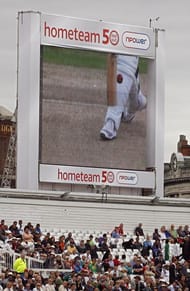On the other hand, it does create an unbalanced situation. While the average Test innings is supposed to last a day and a session (four sessions or approximately 120 overs), will it not be better if the number of reviews for the total innings is increased, rather than have two in the first 80 overs and the remaining two in the last 1/3rd part of the innings?
Giving the captain four reviews at the start and expecting him to use them judiciously would be a better option, because he can decide whether he needs a review now or save them for later, according to how the game stands.
Another point that goes against the DRS is that it reduces the faith in the on-field umpires and also mounts more pressure on the television umpires, who may not be the best ones to use technology effectively to judge an appeal. Australian cricketer Andrew McDonald feels that the ICC have faltered in making this new rule which will waste even more time in the future games when teams will want to take additional reviews.
Just increasing the number of reviews will not help. The Hot Spot technology should be improved so that it can measure results on consecutive deliveries if required, to avoid hassles like the one happened in Trott’s case (it was apparently non-available – whatever the cause, it should be straightened out).
A look at the existing rules might also help, so that incorrect human decisions on the field are overturned and correct decisions are upheld. Technology is sure to provide better answers than a naked eye on the field, and when in doubt, the results of the replay should be given a higher preference even if it may not be 100% conclusive. It will definitely be less erroneous than an on-field decision.
There has been a talk going on to train the television umpires to make them more tech-savvy so that they can use technology better to make decisions. This is a step on the right direction and should be carried out as fast as possible. Moreover, keeping a techie in the television room who can assist the umpires can be tried.
Most of the reviews that are called, are either for leg-before appeals or nicks that were not certain. So to speed up the referral system, the Hawk Eye that maps deliveries should be used for every delivery if possible, instead of only when a review is sought, which wastes time.
In case of an appeal, the television umpire checks the trajectory which is mapped as soon as the ball is bowled and the Hot Spot is fast enough to confirm an edge, the third umpire can communicate with the on-field umpire as soon as a review is requested. Sure, a lot of resources, people and money will go into this but it will definitely be worth it given the embarrassment ICC is facing with the UDRS controversies.
Only time will tell how the new rule pans out and how effective it proves to be. Let us hope that the return Ashes starting after next month will be less controversial in this regard.
Follow IPL Auction 2025 Live Updates, News & Biddings at Sportskeeda. Get the fastest updates on Mega-Auction and cricket news

